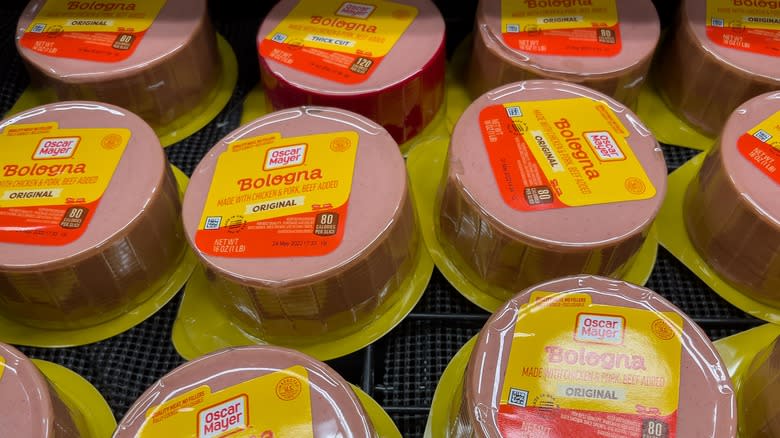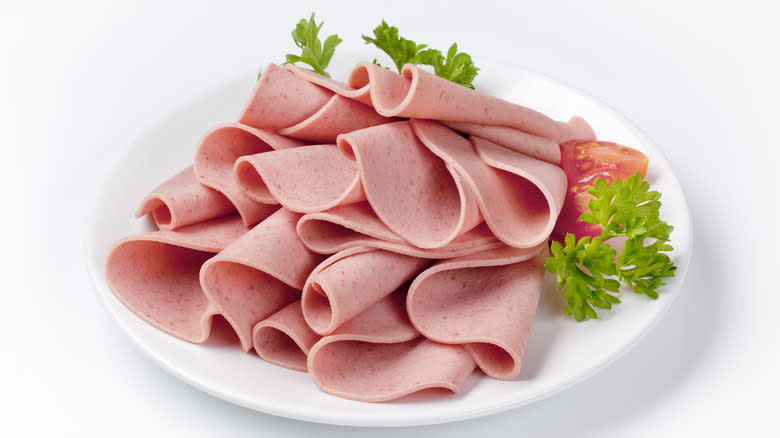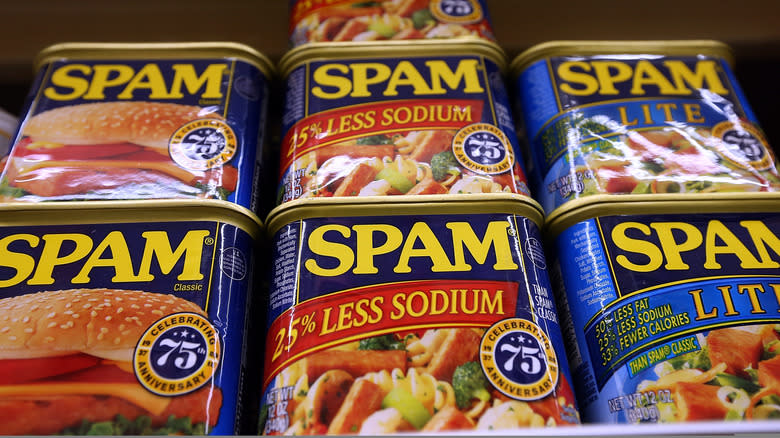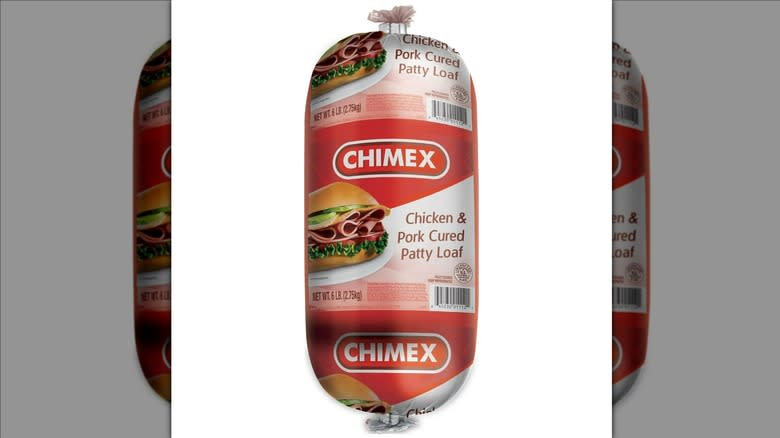The Biggest Myths About Bologna Debunked

Bologna has been part of the American diet since the early 20th century. For decades, its simple, cheap, and versatile nature has seen the sliced sausage form the basis of packed school lunches and family dinners alike. Bologna remains popular today, with Americans buying over 225 million pounds of it from retail stores annually. Yet despite its prevalence, bologna is still a misunderstood food; the public continues to believe several myths concerning this so-called mystery meat. We're here to debunk these myths.
This is no small task. In the United States, bologna's rise occurred hand-in-hand with that of the sandwich. Its popularity endured largely due to nostalgia. While the country continues to buy millions of pounds of bologna, it looks unlikely that, unless anything is done, the public will come any closer to respecting or understanding this noble sausage. After all, it's pretty much impossible to change the public's perception of a meat once its name has become synonymous with nonsense. Be that as it may, we're going to try. Get ready to learn the truth about humble, delicious bologna.
Read more: 11 Things You Didn't Know You Should Be Doing With Bacon
Myth: It Was Invented In America

People often assume that bologna was invented in the United States. It's understandable why; the sausage is widely consumed in the U.S. and the country is home to several notable bologna producers. Chief among these is Oscar Mayer, a Chicago-based company with bright yellow packaging that popularized the sausage during the 20th century. Despite this, it's more accurate to define bologna as an Americanized food, not an American food. That's because bologna is derived from mortadella, an Italian sausage that has been made in the city of Bologna for centuries.
Although no one is certain, it's thought that mortadella was brought to the U.S. by German immigrants. As with many other foods, the sausage changed over time to become something wholly unique -- in this instance, the American bologna we know today. American bologna differs from Italian mortadella in several ways. Unlike mortadella, it does not boast a multi-textured interior that's studded with fat and other ingredients. Instead, bologna's interior is uniform and smooth. What's more, bologna is produced from a variety of meats whereas mortadella is only made with pork. Finally, many people hold the view that bologna is a less flavorful, fatty, and artisanal sausage than mortadella. That's up to personal interpretation.
Myth: It's Made From Mystery Meat

Bologna is made up of finely ground ingredients that give it a uniform appearance and texture. This appearance makes it impossible for people to discern the sausage's ingredients when looking at it. While fat, pistachios, and other ingredients are plainly visible in mortadella, bologna holds no such giveaways. Ultimately, this has led some Americans to label bologna as mystery meat, poking fun at the product by suggesting it has unsavory origins.
Bologna enthusiasts will be happy to learn that these accusations are unfounded. As with any meat product, the production of bologna is carefully regulated by the United States Department of Agriculture. According to these regulations, bologna cannot contain more than 30% fat, 10% water, 3.5% non-meat binders, and 2% isolated soy protein. The USDA also highlights that bologna can only be made from beef, turkey, pork, or chicken.
Even bologna made with offal ("variety meats" in USDA-speak) is tightly regulated. These sausages are stipulated by law to contain at least 15% raw skeletal muscle. These guidelines show that, far from being a mystery meat, bologna is actually a well-regulated sausage with origins that are just as clear as any other American meat product.
Myth: Spam And Bologna Are The Same

Humans have a habit of lumping foods into categories. The problem with doing this is that we soon start to conflate one food with another, as is the case with Spam and bologna. Both of these foods are processed meats with a smooth texture and less than stellar reputation. What's more, Spam and bologna are often prepared in similar ways with slices being fried to develop a crisp, browned crust. These similarities have led members of the public to suggest that the two products are, for all intents and purposes, the same.
Despite what some people think, Spam and bologna are not the same product. For starters, Spam is made with fewer ingredients -- six to be exact. Oscar Mayer's bologna contains over 20. There are also differences in how the two products are defined. The United States Department of Agriculture defines bologna as a frankfurter. Spam, on the other hand, is defined as a luncheon meat. Finally, the two foods are often used to make different dishes, with bologna being used to make sandwiches and Spam being used to make dishes such as Spam musubi.
Myth: There's Only One Type Of Bologna

Due to the popularity of bologna products from corporations such as Oscar Mayer, large numbers of the public believe that this mass-produced style of bologna is the only type available. This is false. The United States is actually home to many different types of bologna, most of them tied to a specific geographic region.
Perhaps the most impressive of all these varieties is Lebanon bologna, a sausage that's made in a small Pennsylvanian town. Unlike traditional bologna, Lebanon bologna is actually a fermented sausage that's traditionally made with beef. This coarse-grained sausage is beloved in Dutch Pennsylvania, where its sweet and sour flavor profile sees it served in a variety of ways.
Ring bologna is another popular variety. As the name suggests, this sausage is packed into narrow casings and formed into a large ring. Often, this sausage carries an intense, smoked flavor. Rag bologna is another variety that stands in direct contrast to ring bologna. This sausage hails from West Tennessee and is often sold in thick chunks. Thanks to a high fat and filler content, rag bologna has a much softer texture than other types of bologna.
Myth: Only America Produces Bologna

Even though it originated in Italy, bologna is a distinctly Americanized food. Due to this, there is a common myth that American-style bologna is only produced in the United States. In reality, bologna is made in several countries, Mexico among them. Mexican bologna is highly sought after in the U.S. due to its higher pork content.
While brands of bologna such as Chimex are often imported, a great deal of Mexican bologna is illegally smuggled into the U.S. before being sold on sites such as Facebook and Craigslist. While such a practice may seem harmless to some, smuggled meat products can have a huge impact on the American agricultural industry. Speaking to Newsweek, director of field operations at U.S. Customs and Border Protection Hector Mancha said, "Pork products have the potential to introduce foreign animal diseases that can have devastating effects to the U.S. economy and to our agriculture industry." That's right -- bologna is serious business.
Myth: Bologna Is Not Widely Eaten Anymore

Bologna sales dipped during the 1990s, falling by at least one percent every year. Despite surges during times of economic uncertainty, bologna sales have remained relatively low since this time. These sales figures, and the fact that many Americans who grew up eating bologna have vowed to never touch it again, lead some to believe that bologna isn't widely eaten anymore. While the public's consumption of bologna may have dropped, there is still one institution where the sausage is eaten in great quantities: the prison system.
Bologna is used to feed incarcerated people for the simple fact that it is a cheap, readily available protein. Usually, bologna is served in a sandwich as part of a sack lunch and is sometimes given to inmates for weeks on end. In the past, sheriffs have even boasted about how much money they've saved by swapping out inmates' hot dinners for bologna sandwiches. These meals do little to satisfy inmates and an overreliance on them can lead to long term health problems including heart disease and diabetes.
Poor quality (even rotten) bologna has been served to incarcerated people across the nation. The toll it takes on them is enormous, as activist Sarah Kahn explained to Voice of OC: "People describe it as torture eating these horrible bologna sandwiches day after day after day and having a cold hard boiled egg in the morning alongside more bologna in slices of bread is really not a significant difference."
Myth: You Can't Eat It When Pregnant

According to The American College of Obstetricians and Gynecologists, pregnant women are 10 times more likely to suffer from listeriosis, a foodborne infection caused by listeria bacteria. Listeriosis can be fatal to fetuses. As a result, women are encouraged to avoid some foods during their pregnancy, including certain meat products like bologna and raw milk cheeses, which can carry listeria. This has led people to believe that bologna cannot be consumed at all during pregnancy.
Cool and cold temperatures do not kill listeria. Hot temperatures do. For this reason, the Center for Disease Control and Prevention states that meats including bologna can be safely consumed by pregnant women if heated to 165 degrees Fahrenheit before being consumed. It is important that the meat is consumed soon after being heated. When speaking with Today, maternal-fetal care specialist Dr. Steve Rad said, "Per USDA, these should be eaten soon after heating and should not be allowed to stay at room temperature or returned to refrigeration temperatures. When heating these meat products in the microwave, verify that the products reach this temperature throughout."
Myth: Chefs Don't Value Bologna

Given the low esteem some people hold bologna in, it's easy to believe that those who make their living by cooking also turn their noses up at it. This isn't the case. In fact, many famous chefs have sung bologna's praises, including David Chang, who served duck bologna at Momofuku Ssam Bar. Chang's opinion is that bologna is a blank canvas, and that budding chefs and producers can tweak bologna recipes to suit their tastes while remaining free from the customs associated with more historic foods, like mortadella.
Many chefs in America back up this viewpoint, using bologna in a myriad of inventive and effective ways. One example comes from The Dutch, a restaurant located in Philadelphia. Here, bologna is used to make a version of eggs benedict, and is served alongside creamed chipped beef. Elsewhere, chefs are serving their own version of the traditional fried bologna sandwich, improved through the use of a few culinary tricks. In an interview Food & Wine, Chef Craig Deihl said, "I like bologna crispy, whether it's sliced thin or thick, but it's got to be grilled hard and crispy. That's the way we do it at Hello, Sailor, but we slice the bologna thick and smoke each individual slice so it's got more flavor."
Myth: It's Only Used In Sandwiches

Bologna's most famous and prevalent culinary use is as a sandwich filling. However, this does not mean that making sandwiches is the only thing bologna is good for. There are many novel ways to use bologna in the kitchen, one of the most common being to fry it up and serve it for breakfast alongside scrambled eggs. Celebrity chef Matty Matheson goes one further, serving up four slices of fried bologna topped with a fried egg and a slice of American cheese. Even fast food chains have gotten in on the act, with brands such as Hardee's sporadically adding fried bologna stuffed biscuits to its menu.
It's not just breakfast that bologna is suited to. Some home cooks suggest serving it with pasta and a simple tomato sauce, as well as on top of cheese and crackers. In short, bologna can be used for a huge variety of dishes, not just sandwiches.
Read the original article on Daily Meal

